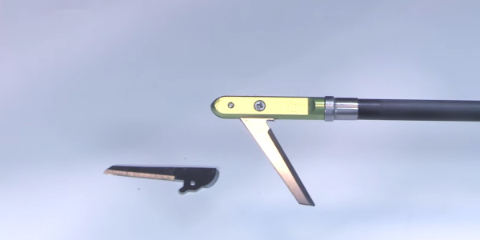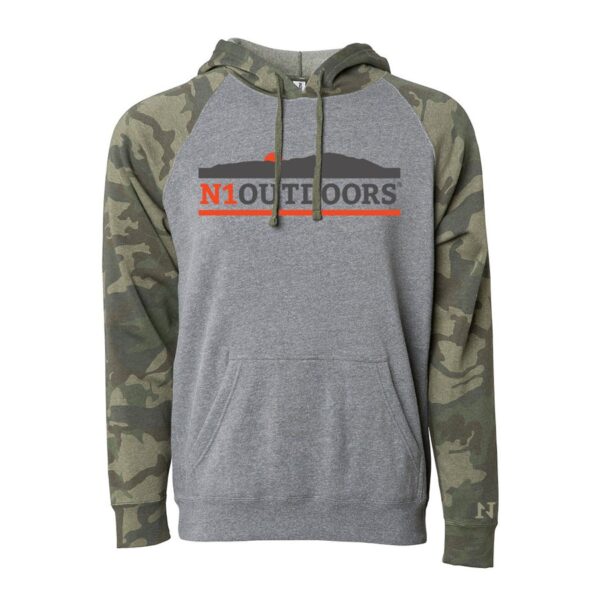In this review, I test a really cool, innovative, and crazy-looking broadhead to test here today. It’s the Project One by Mohican Sneak.
This thing is definitely weird-looking. But, I was wondering if it might end up being weirdly awesome!
I used my Bowtech SR6 set at 72 pounds and Bishop FOC King Arrows for most of the shots. For really hard impacts shots, I used thee the Bishop FAD Eliminator.
A Closeup Look At the Project One by Mohican Sneak
Here’s a good look at the Mohican Sneak.

What a cool-looking broadhead this is! This is the kind of broadhead you just want to look at for a little while to try to figure out. It’s a 2-blade fixed blade broadhead. Those blades didn’t swing into that position. That’s their actual starting and ending position.
The cutting edges of the Project One head are staggered. So, it penetrates with the leading blade and tip, which is sharpened all the way around, and then the second blade begins to penetrate. They say that staggering the blades increases the penetration ability.

The blades are single bevel, but are sharpened on both opposite sides.
In addition, each of the blades are single bevel, and sharpened on the back and on the front. That single bevel is designed to hopefully make a maybe a circular wound channel. If so, it would make wound a bit more difficult to close up.

Now, the cutting diameter of the Project One is a full 2-1/2″. And that’s on impact because these don’t open or close. This is a fixed blade broadhead. So you’re going a full 2-1/2″ of cut from the get-go.
-

Just Pass’N Through™ Tee featuring Iron Will (Various Colors)
Price range: $24.99 through $28.99 Select options This product has multiple variants. The options may be chosen on the product page -
Sale!

N1 Outdoors® Whitetail Sugar Skull Tee (Black/Columbia Blue)
$19.00 Select options This product has multiple variants. The options may be chosen on the product page -

N1 Outdoors® “USA Antler” Tee
Price range: $24.99 through $28.99 Select options This product has multiple variants. The options may be chosen on the product page

The ferrule is aluminum (although I’m not sure what kind of aluminum) and the blades are stainless steel (0.040 inch thick). Being sharpened on the back in single bevel fashion will make them a little bit easier to pull out of a target.
Sometimes as an animal moves, a lodged arrow tends to back out of the animal. So, if that happens with this broadhead, it’s going to be cutting tissue as it backs out.

I will note that as I was looking at this broadhead, one of the blades was a bit curved, and the others aren’t like that. That’s not by design. That’s just some kind of quality control thing. So, I’m not sure what to make about that.

Mohican Sneak Testing
I was really eager to put the this head to the test. I was also very curious about the flight and the durability.
Without a chiseled tip, and it looks like just one set screw holding the leading blade in place, I was anxious to see how it would hold up. So, let’s check out how this Mohican Sneak fared in the testing!
Flight Test
I had a few obstacles when testing flight that changed the way I did this test. First was the weather. I couldn’t get out where I normally do due to the conditions.
And, I was also down down to only one broadhead because the other two broke in some of the tests that you’ll see later in this review.
So, I was down to one head and I didn’t want to shoot it really far because I wasn’t sure how it would fly. So, I shot only one of the broadheads and one field point at 25 yards.

The first shot with the broadhead hit way to the right. But man, check out the gash that this thing made.
Although the first shot with the broadhead was really wide right, it made and incredible slash in my target. I mean it just cut like an axe through my target. Very impressive.

The second shot with the broadhead was better, but still pretty unforgiving. See the broadhead shot in the middle? The dot on the left is where I was aiming! I hit that same dot with a field point.
Initial Sharpness Test

The initial sharpness test registered 250 on the tester.
Penetration Test #1 (2/3″ rubber mat, 1/2″ MDF, FBI Gel):

The Project One penetrated 5-1/2″. Check out the entrance hole. The cut was 2-1/2″ as expected. However, the head didn’t rotate much in the gel, and it actually lost a blade.
I think I’ve only lost a blade a couple times in all of the different tests that I’ve done. However, this was one of those times.
The main blade was in perfect shape, but it broke off at the pin. So the pin that holds it in place at the top somehow broke off or got dislodged in some way, causing the blade to just fall out.

Here’s the head after penetration test 1. And unfortunately, it lost a blade in the gel after it passed through the 2/3″ of rubber foam mat and the 1/2″ of MDF. That’s really rare that that happens.
It’s rare that the first penetration test turns into the durability test, because it’s not intended to do that. However, since the durability test is actually shooting into a 1/2″ of MDF, that’s what happened and unfortunately it didn’t pass.
So, it only got a score of 2 points on the durability test because it did make it through that 1/2″ of MDF. The ferrule is in good shape, but it lost a blade.

Here’s a look at the entry hole when I shot the head into the foam matting/MDF/ballistic gel.
-

N1 Outdoors® N-Tune™ Nock Tuning Reflective Arrow Wraps – Honeycomb (Various)
Price range: $18.99 through $27.99 Select options This product has multiple variants. The options may be chosen on the product page -

N1 Outdoors® N-Tune™ Nock Tuning Reflective Arrow Wraps – Dropp’N Hammers™
Price range: $18.99 through $27.99 Select options This product has multiple variants. The options may be chosen on the product page -

N1 Outdoors® N-Tune™ Nock Tuning Reflective Arrow Wraps – Old Bloody Glory™
Price range: $18.99 through $27.99 Select options This product has multiple variants. The options may be chosen on the product page
Edge Retention Test (sharpness after Penetration Test #1):

The Mohican Sneak Project One tested 275 in the sharpness test after penetration test #1.
Penetration Test #2 (layered cardboard):

It penetrated through 52 layers and that’s quite a bit considering its cut size.
Angled Shot Test (1/4” MDF/Carpet):
I wondered if the Mohican Sneak would be able to do well on the angled shot, and actually, it did. But, unfortunately, it lost a blade on that angled shot.
In this instance, it looks like the blade just completely broke off inside my target.

The angled shot test proved to be another “durability” test… and it didn’t fare too well. Once again, it lost a blade.
So, I had a 1/4″ of MDF followed by my target beyond that and I don’t know if it broke off when I was pulling it out, or it broke off as it was going in. But I just know when I pulled it out, it only had one blade.
The penetration test and the angled test are not intended to be durability tests and yet, in both of those different tests, it lost a blade.
Final Thoughts And Score of the Mohican Sneak Project One Broadheads
So what do you think of the Project One by Mohican Sneak?
I’ve got to tell you, I love the innovation. I love the creativity. I love the cut size. Wow!
When you see the swath that it cuts in gel or in cardboard or in my target, it’s really impressive.
I can imagine that’s going to do some serious damage on an animal that it hits.
The durability, however, was very questionable.
It’s rare that I have a head break in penetration test #1, and it’s really rare that I have one break on an angled shot through just a 1/4″ of MDF. And yet, it did on both of those.
So, the durability was really disappointing. I couldn’t go on and do the other remaining durability tests because it didn’t even make it through those.
And, then the flight… it’s very rare that a broadhead does not fly extremely well out of my bow and setup.
Now, as I mentioned, I wasn’t able to go to my normal place to shoot because the weather is just so cold and there was a bit of a wind.
So, wind could have played a factor in that. There was a 15 mile-per-hour crosswind. Yet, I was only shooting out to 25 yards because that’s the maximum distance I could get in the spot and it’s relatively protected from the wind. And yet, I shot it a few times, and each time, it was quite a bit to the right.
In my opinion, this is not a very forgiving head when it comes to flight.
It doesn’t mean you can’t get it to fly well out of your bow.
It wasn’t that I couldn’t get it to fly well out of my bow if I really tried. But just testing it like I do all the other heads, it was quite a bit challenged in terms of flight forgiveness.
So, look through the score sheet and see what you think about the areas that matter to you the most.
Best of luck in your bowhunting adventures!

































